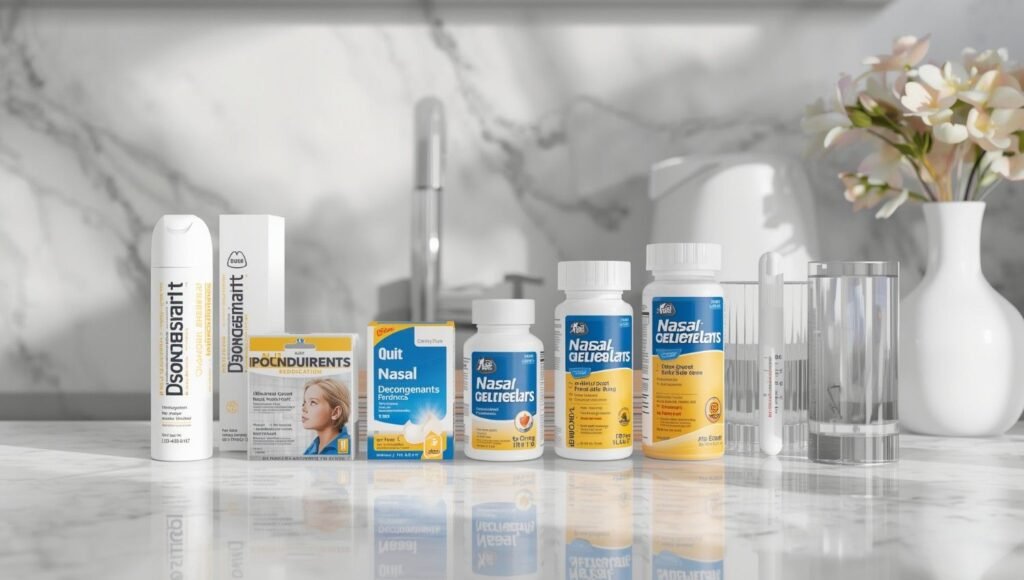Introduction
Dealing with a stuffy nose can be incredibly frustrating, especially when it constantly affects your daily life. The full feeling in your face and the struggle to breathe can make even simple tasks difficult. Most people don’t realize how nasal congestion happens — it’s when the tissues, blood vessels, and lining inside your nose swell due to inflammation. This reaction is often caused by environmental substances that irritate or inflame your nasal passages, like smoke, dust, or other irritants. Sometimes, a virus, infection, or cold can trigger it too. Even allergies, flu, or a nonallergic rhinitis known as vasomotor rhinitis might be the cause. As an ENT patient myself, I once learned from specialists at South Florida ENT Associates that congestion can also result from inflamed sinuses, sinusitis, or swelling in the nasal tissues.
If your runny nose comes with watery secretions that leak down your throat, it’s often due to overproduction of mucus in the nasal passages. The fluid running from your nose or down your throat can make the condition worse. It’s not just a minor annoyance — it can truly impact your comfort and well-being. Thankfully, there are effective treatment options and tips to get rid of congestion. With a bit of care and consistency, you can find relief and breathe freely again, whether your congestion is referred to as sinusitis, an infection, or a reaction to environmental irritants.
Why is my nose stuffy?
A stuffy nose often feels like a plugged-up barrier that makes it hard to breathe, leaving you searching for relief and comfort. The most common reasons for this discomfort include an infection, sinusitis, or a cold, each of which can lead to nasal congestion. The symptoms usually begin when your nasal tissues swell due to inflammation, blocking airflow and trapping mucus. From my own experience, the first step toward feeling better is identifying the real cause — whether it’s allergies, illness, or even dry air — since each needs a slightly different treatment.
Once you understand the cause, you can explore options to improve your breathing and find what works best for you. Saline sprays, steam inhalation, or gentle decongestants often help ease the pressure and open your airways. Knowing how to pinpoint and manage the issue makes all the difference between ongoing congestion and real relief.

How to Get Rid of a Stuffy Nose?
When your nose feels congested, it can make it hard to breathe or rest. The mucus buildup and nasal congestion often come from a cold, infection, or allergies that leave your passages blocked. I’ve dealt with this before—especially during the flu season—and learned that simple tips can make a big difference. If your symptoms last for weeks, talk to a doctor for the best treatment. Otherwise, over-the-counter (OTC) medications and home remedies can help clear your airways and bring relief. Gentle care can help you breathe easier and speed your recovery by restoring proper airflow.
1-Nasal wash
One of the best ways to ease a stuffy head is to rinse your nasal passages. Use an irrigation kit, neti pot, or bottle with a saline solution to wash, soften, and loosen mucus. I often make my own at home using warm, distilled water, a pinch of baking soda, and salt—a homemade mix that works like those sold at the drugstore. Use one teaspoon of salt per cup of water, and repeat daily for best results. This gentle nasal wash helps clear congestion quickly and safely.
2-Steam
Steam therapy can be a lifesaver. A hot shower, bowl of boiling water, or a cup of tea can release warm vapors that thin mucus and ease sinus congestion. I like to place a towel over my head and breathe in deeply from a bowl of hot water—this simple routine offers instant relief. Repeat it a few times daily to drain your nose and sinuses while keeping the airways moist and comfortable.

3-Chicken soup
A classic remedy, chicken soup is more than just comfort food. The warm broths can help loosen mucus, ease symptoms, and give short-term relief from congestion. I always sip a warm drink when sick; it’s a traditional cure that soothes the throat and supports recovery.
4-Devices
Modern technology also plays a role. A bioelectronic sinus device works by sending microcurrents through nerve fibers, helping to reduce inflammation, pain, and headache. These OTC devices are designed to ease congestion and can complement other treatments for faster relief.
5-Decongestants
When you’re sick and your blood vessels swell, the airways narrow, causing that heavy, stuffy nose feeling. OTC decongestants, such as phenylephrine or pseudoephedrine, can shrink these vessels to help you breathe better. Sprays offer fast results, but read the label carefully—overuse can make you irritable, nervous, and even worsen congestion. Use with caution and always limit usage for safe, lasting relief.
6-Peppermint
Peppermint is a natural decongestant that clears the chest and nasal mucus. The menthol in peppermint tea, rubs, or cough drops has a soothing aroma and helps open airways. I love to steep a teaspoon of dried peppermint in boiling water for ten minutes; the drink offers relief several times a day and helps me breathe easier.
7-Best Medicine for a Stuffy Nose
If home remedies aren’t enough, nasal decongestants from your local pharmacy can bring quick relief. Common medications include pseudoephedrine and oxymetazoline, or combinations with ibuprofen, loratadine, acetaminophen, guaifenesin, or cetirizine. Popular brands like Afrin®, Zicam®, Sudafed®, Advil Cold and Sinus®, Claritin-D®, Tylenol Sinus Severe Congestion Daytime®, and Zyrtec-D® target symptoms like blockage and restore airflow. Always check the dosage, label, and whether the medication includes a pain reliever or antihistamine for your treatment plan.
8-Newborn Stuffy Nose Treatment
For a baby or infant, gentle care is key. Use saline solution drops in each nostril, then a rubber suction bulb to clear mucus. A humidifier or warm shower can add moisture, while a wet cotton swab offers relief. Always ensure breathing stays easy—gentle care helps keep tiny noses clear and comfortable.

Stuffy Nose At Night: What to Do
Nighttime triggers like pollen, pet dander, dust, mold, or cigarette smoke can worsen stuffy nose symptoms. Even fumes from a fireplace, car, or cleaning products may aggravate irritants. When blood flow changes while lying down, congestion increases. Try to elevate your head with extra pillows—it improves airflow, relieves breathing, and reduces discomfort from allergies in your environment.
Stuffy Nose and Sore Throat
When your stuffy nose comes with a sore throat, it might signal a cold, flu, or COVID-19. Your doctor can give a proper diagnosis and recommend treatment. Prescription or OTC medication, along with rest, hydration, and care, helps your immune system fight the infection for faster recovery and relief.
Stuffy Nose and Headache

A headache with a stuffy nose often points to sinusitis, infection, or allergies. Conditions like respiratory syncytial virus, migraine, nasal polyps, or inflammation in the sinuses can all cause pressure and pain. A quick doctor appointment ensures proper diagnosis and treatment for complete relief.
1-Drink plenty of fluids
Fluids and hydration help the body flush mucus and reduce sinus pressure. Drinking water frequently improves circulation, eases inflammation, and supports overall healing. It’s a simple yet powerful habit to reduce discomfort and speed recovery.
2-Drain your sinuses with a neti pot
A neti pot is a small container with a spout that lets you pour saline solution or distilled water into one nostril. This rinse washes away mucus, cleans passages, and provides sinus relief. Regular flush routines maintain nasal hygiene and clear congestion naturally.
3-Use a saline nasal spray
A saline nasal spray adds moisture to hardened passages and helps dissolve mucus. Your doctor or ENT may prescribe a stronger decongestant medication for deeper relief. Proper hydration keeps tissue healthy and clear, reducing irritation and promoting comfort.
4-Relieve symptoms with over-the-counter medications
Allergies can cause a stuffy nose, so an antihistamine or decongestant medication can help you breathe freely. They work by shrinking swollen blood vessels in the sinuses. Always consult an ENT before using sprays too often, as prolonged use may cause tissue damage, irritation, or worsening symptoms. Proper diagnosis ensures safe relief.
5-Use steam to thin mucus
Steam loosens mucus, helping to unclog your nose. Try a hot shower, boiling water bowl, or tea—the vapor hydrates nostrils, soothes tissues, and eases congestion. Using a humidifier can also improve air quality, relieve allergies, and provide ongoing comfort.
Identify And Address Any Underlying Cause
If nasal congestion lasts, an ENT from South Florida Associates can help detect anatomic obstructions like a deviated septum or nasal polyps. Chronic symptoms may need advanced treatment or consultation to restore healthy airways and lasting relief.
1. Drinking a Hot Beverage
A hot beverage is a time-tested remedy for cold symptoms. According to a scientific study in Rhinology (2009), warm liquids help lessen signs of illness and promote a comforting body response. Whenever I’m congested, sipping tea provides both physical and psychological comfort that aids recovery.
2. Inhaling Hot Steam
Inhaling hot steam can quickly relieve cold symptoms. Adding herbs or essential oils to hot water enhances the treatment. A 2015 Journal of Dental and Medical Sciences study confirmed steam inhalation improves congestion and speeds symptom alleviation—a simple, effective home remedy for relief.
3. Getting Lots of Sleep
Getting enough sleep is essential for immune recovery. During rest, your body releases cytokines—proteins that repair inflammation and fight infection. Adequate sleep helps regeneration, healing, and restores energy, keeping your immune system strong for ongoing restfulness and recovery.
4. Eating a Spicy Meal
A spicy meal rich in capsaicin from chili peppers can ease nasal flow and relieve a runny nose. Though the heat may make your nose run more at first, it helps stimulate mucus drainage. I often rely on spicy food for quick, temporary comfort—it’s a natural therapy that really works.
5. Having a Hot Shower
A hot shower offers instant relief by letting steam clear a runny, congested nose. The humidifier-like vapors and facial moisture improve breathing and reduce sinus pressure. It’s a simple therapy that brings comfort, warm air, and ease almost immediately.
When Should I Contact a Doctor to Treat a Runny Nose?
A runny nose might seem harmless, but it’s important to know when to see a doctor or healthcare provider for proper treatment. If your symptoms show no improvement after ten days or become persistent, severe, or unusual, it’s time for a check-up. I once ignored mine for too long and ended up with a minor infection, so I’ve learned that early evaluation helps prevent complications. Parents should also watch for a child’s nasal drainage that comes from only one side, especially if it’s green, red, or foul-smelling—it might signal an obstruction or foreign object. Your doctor may perform a physical exam and diagnosis to rule out any serious cause and ensure the right treatment.
When is it time to see a doctor for a stuffy nose?
Most cases of a stuffy nose respond to self-care, but certain warning signs mean it’s time for medical attention. If a baby has congestion, fever, or difficulty breathing during nursing, see a professional right away. Adults should visit a doctor if symptoms last more than ten days, the discharge is yellow or green, or if there’s sinus pain, high fever, or even blood in the mucus. Persistent clear discharge after a head injury also requires urgent ENT consultation to rule out deeper issues. Understanding these signs ensures safe treatment and faster relief from bacterial infections or blocked sinuses.
Why see the ear, nose, and throat specialists?
At Texas ENT Specialists in Houston, experts treat complex nasal and sinus problems using medical, minimally invasive, and surgical options. Their rhinologists and subspecialists apply the latest techniques and advanced diagnostic methods to deliver individualized care. I’ve seen how a tailored treatment plan improves quality of life by targeting the root of the problem instead of just the symptoms. Their deep experience ensures that every patient receives the best modern treatment available from trusted specialists.
What can cause a stuffy nose?
Nasal congestion can arise from a cold, flu, sinus infection, or allergies. It can also be triggered by irritants like automobile exhaust or tobacco smoke. In some cases, structural problems in the nasal cavity or sinuses—such as a deviated septum, enlarged adenoids, or nasal polyps—create blockages that cause obstruction and inflammation. Doctors may suggest balloon sinus dilation or surgery as part of your treatment to restore clear breathing. I once struggled with recurring sinus pain, only to discover a mild deviation in my septum was behind my congestion—a quick fix brought lasting relief.
What home treatments can help a stuffy nose?
You can treat a stuffy nose with simple self-care routines at home. Keep moisture in the air using a humidifier, vaporizer, or steam from a hot shower. I like to hold a warm towel over my face to relieve discomfort and open my sinuses. A saline nasal spray or wash can reduce swelling and clear your passages. For stronger relief, decongestants, antihistamines, and allergy medications can help ease symptoms. Products with menthol, camphor, or ointment formulas make it easier to breathe, while pain relievers such as ibuprofen or acetaminophen soothe sinus pressure and pain. These remedies, when used properly, bring fast, safe relief and lasting comfort.
Takeaways
A stuffy nose often feels like fullness in the face, caused by mucus running from the throat or nose due to colds, flu, allergies, or irritants such as smoke and dust. Some people develop nonallergic rhinitis, which causes similar symptoms without infection. To relieve congestion, try nasal washes with a neti pot, breathe in steam, sip chicken soup, or use decongestants and OTC medicines like Sudafed. If you use sprays, be sure to avoid overuse and limit them to a few days. With consistent treatment, you can find lasting relief and breathe freely again.

Frequently Asked Questions (FAQs)
1. What causes a stuffy nose?
A stuffy nose happens when nasal tissues and blood vessels become inflamed or swollen, often due to infection, sinusitis, a cold, or allergies. Exposure to irritants like smoke, dust, or environmental substances can also trigger congestion. Sometimes, structural issues like a deviated septum or nasal polyps can block airflow and worsen the condition.
2. How long does a stuffy nose usually last?
In most cases, nasal congestion improves within ten days. However, if the symptoms persist longer, become severe, or don’t show improvement, it’s best to consult a doctor or ENT specialist for further evaluation and treatment.
3. What is the best home remedy for a stuffy nose?
A nasal wash using a neti pot or saline solution works well to clear mucus and open up the sinuses. You can also inhale steam, take a hot shower, or sip warm drinks like chicken soup to relieve congestion. Using a humidifier, vaporizer, or saline nasal spray can add moisture and ease breathing.
4. Can decongestants help with a stuffy nose?
Yes — OTC decongestants like phenylephrine, pseudoephedrine, or oxymetazoline can shrink swollen blood vessels and help you breathe easier. Common brands include Sudafed, Afrin®, and Zicam®. Always check the label, follow the dosage, and avoid overuse for more than a few days to prevent rebound congestion.
5. When should I see a doctor for a stuffy or runny nose?
You should seek medical attention if your symptoms last more than ten days, if your discharge is green, yellow, or contains blood, or if you experience sinus pain, high fever, or difficulty breathing. A child with a fever or one-sided nasal drainage should be evaluated for possible infection or obstruction.
6. Can babies get a stuffy nose, and how can I help them?
Yes, babies and infants often experience mild nasal congestion. You can use a few drops of saline solution in each nostril, followed by a rubber suction bulb to clear mucus. Running a humidifier or sitting in a warm shower can add moisture and make breathing easier.
7. Are natural remedies like peppermint and steam safe?
Absolutely — peppermint, menthol, and steam inhalation are gentle and natural decongestants. Drinking peppermint tea or inhaling steam vapors from a bowl of hot water can soothe tissues, thin mucus, and promote relief. Just be cautious not to use boiling water too close to your face.
8. Why is my nose stuffy at night?
Nighttime congestion can result from allergies, pollen, pet dander, mold, or irritants like cigarette smoke. When you lie down, blood flow to the nasal tissues increases, causing more swelling. Try elevating your head with pillows, using a humidifier, and keeping your room allergen-free.
9. What if my stuffy nose is linked to a headache or sore throat?
A stuffy nose accompanied by a headache or sore throat might indicate sinusitis, a cold, the flu, or COVID-19. In such cases, visit your doctor for proper diagnosis and treatment. They may recommend OTC medication, rest, and hydration to boost your immune system and ease symptoms.
10. How can I prevent a stuffy nose in the future?
Keep your nasal passages moist by staying hydrated and using a saline spray during dry seasons. Avoid irritants such as smoke, strong fragrances, or polluted air. Regularly clean your living environment and manage allergies with antihistamines or decongestants as needed. Preventing exposure to triggers is the best long-term strategy for congestion-free breathing.




